|
||||||||||||||||||||||
![Home - Air Power Australia Website [Click for more ...]](APA/APA-Title-NOTAM.png) |
||||||||||||||||||||||
![Sukhoi PAK-FA and Flanker Index Page [Click for more ...]](APA/flanker.png) |
![F-35 Joint Strike Fighter Index Page [Click for more ...]](APA/jsf.png) |
![Weapons Technology Index Page [Click for more ...]](APA/weps.png) |
![News and Media Related Material Index Page [Click for more ...]](APA/media.png) |
|||||||||||||||||||
![Surface to Air Missile Systems / Integrated Air Defence Systems Index Page [Click for more ...]](APA/sams-iads.png) |
![Ballistic Missiles and Missile Defence Page [Click for more ...]](APA/msls-bmd.png) |
![Air Power and National Military Strategy Index Page [Click for more ...]](APA/strategy.png) |
![Military Aviation Historical Topics Index Page [Click for more ...]](APA/history.png)
|
![Intelligence, Surveillance and Reconnaissance and Network Centric Warfare Index Page [Click for more ...]](APA/isr-ncw.png) |
![Information Warfare / Operations and Electronic Warfare Index Page [Click for more ...]](APA/iw.png) |
![Systems and Basic Technology Index Page [Click for more ...]](APA/technology.png) |
![Related Links Index Page [Click for more ...]](APA/links.png) |
|||||||||||||||
![Homepage of Australia's First Online Journal Covering Air Power Issues (ISSN 1832-2433) [Click for more ...]](APA/apa-analyses.png) |
|
|||||||||||||||||||||
| Last Updated: Mon Jan 27 11:18:09 UTC 2014 | ||||||||||||||||||||||
|
||||||||||||||||||||||
|
||||||||||||||||||||||
![Home - Air Power Australia Website [Click for more ...]](APA/APA-Title-NOTAM.png) |
||||||||||||||||||||||
![Sukhoi PAK-FA and Flanker Index Page [Click for more ...]](APA/flanker.png) |
![F-35 Joint Strike Fighter Index Page [Click for more ...]](APA/jsf.png) |
![Weapons Technology Index Page [Click for more ...]](APA/weps.png) |
![News and Media Related Material Index Page [Click for more ...]](APA/media.png) |
|||||||||||||||||||
![Surface to Air Missile Systems / Integrated Air Defence Systems Index Page [Click for more ...]](APA/sams-iads.png) |
![Ballistic Missiles and Missile Defence Page [Click for more ...]](APA/msls-bmd.png) |
![Air Power and National Military Strategy Index Page [Click for more ...]](APA/strategy.png) |
![Military Aviation Historical Topics Index Page [Click for more ...]](APA/history.png)
|
![Intelligence, Surveillance and Reconnaissance and Network Centric Warfare Index Page [Click for more ...]](APA/isr-ncw.png) |
![Information Warfare / Operations and Electronic Warfare Index Page [Click for more ...]](APA/iw.png) |
![Systems and Basic Technology Index Page [Click for more ...]](APA/technology.png) |
![Related Links Index Page [Click for more ...]](APA/links.png) |
|||||||||||||||
![Homepage of Australia's First Online Journal Covering Air Power Issues (ISSN 1832-2433) [Click for more ...]](APA/apa-analyses.png) |
|
|||||||||||||||||||||
| Last Updated: Mon Jan 27 11:18:09 UTC 2014 | ||||||||||||||||||||||
|
||||||||||||||||||||||
The Strategic Impact of China's J-XX [J-20]
|
||||||||
|
Air Power
Australia - Australia's Independent Defence Think Tank
|
||||||||
| Air Power Australia NOTAM 9th January, 2011 Imagery Updates 12th, 15th January, 2011 |
||||||||
Dr Carlo Kopp, SMAIAA, SMIEEE, PEng, Head of Capability Analysis, Air Power Australia |
||||||||
|
||||||||
 Ventral view of Chengdu
prototype during January 11th first flight (Chinese Internet).
|
||||||||
|
||||||||
|
The
emergence of China's new J-XX [J-20] stealth fighter will have a
profound strategic impact, for both the United States and its
numerous Pacific Rim allies. There can be no doubt that it is proof
positive of the absolute and complete failure of the current OSD
driven plan for recapitalisation of the United States tactical
fighter fleet, and the fleets of its allies. Like the Russian T-50
PAK-FA, the J-XX [J-20] is a “game changer” in the sense that the
large scale deployment of operational production examples of these
aircraft invalidates all of the key assumptions central to United
States and allied air power and force structure planning and
development, since the early 1990si.
Whether the J-XX [J-20] is a proof of concept demonstrator, or a prototype for a volume production combat type, what the design demonstrates is that Chinese engineers have mastered advanced stealth shaping techniques. The design displays repeated application of United States developed shaping design rules used previously in the F-22 Raptor design, and in some portions of the F-35 Joint Strike Fighter design. An observer unfamiliar with the background of the J-XX [J-20] could be forgiven for mistaking the type for a Lockheed-Martin developed productii. The accuracy with which the Chengdu engineers replicated key shaping features could be explained by their reverse engineering the design rules from high resolution imagery of US aircraft. However, it also begs some very good questions as to whether this engineering was directly or indirectly aided by less overt means. Exploitation of engineering data acquired by the alleged penetration of United States contractor computer networks would provide equally good or better technical resultsiii. Airframe shaping is absolutely critical in stealth design, and determines the bounds on the achievable Radar Cross Section performance of any design. If shaping is done poorly, the aft and lower fuselage design of the F-35 being a cardinal example, no amount of radar absorbent material or coating compatible with the weight and volume needs of fighter design will overcome the resulting performance problems. Conversely, if shaping is done right, the cardinal example being the B-2A Spirit, then progressive upgrades of the radar absorbent materials and/or coatings over the life of the design can be used to further improve its stealthiv. By cleverly exploiting contemporary United States developed stealth fighter shaping design rules, Chengdu engineers were able to rapidly get an excellent basic shaping design with a minimum of risk and cost, and significant long term stealth performance growth potential, as Chinese absorbent material and coating, frequency selective radome, low signature antenna and engine nozzle technology mature over time. A derivative of the J-XX [J-20] built in 2025 would thus have a much lower radar signature than a 2015 build of the same airframe. |
||||||||
|
The
Capability Potential of the J-XX [J-20] Stealth Fighter
While the introduction of robust stealth shaping is an unprecedented design feature for an indigenous Chinese fighter, another first is an airframe evidently designed for efficient supersonic cruise at high altitudes – the delta-canard configuration is not unlike that adopted by the Russians in the cancelled supercruising MiG MFI design. Supersonic cruise not only kinematically defeats most legacy fighters and Surface to Air Missiles, but confers additional launch range to Air-Air Missiles and smart bombs, provides an energy advantage when merging into close combat, and in a larger design like the J-XX [J-20], yields important productivity gains due to the ability to supercruise to and from targets. The latter can in many circumstances double the effective sortie rate of a bombervvi. In terms of gross sizing the J-XX [J-20] most closely resembles the smaller configurations proposed for the FB-22A “theatre bomber”, which was to be a dedicated bomber and ISR airframe, intended to supercruise to targets at combat radii in excess of 1,000 nautical miles, a niche occupied by the TAC/SAC GD F/FB-111 family of aircraft during the Cold War. Claims that the Chengdu design is a “Sino-F-22A” make little sense, if the latter were true the aircraft would be considerably smaller. Unlike the FB-22 proposals, the J-XX [J-20] is clearly intended for air combat and using a canard-delta configuration will provide both efficient supersonic cruise, and good supersonic and transonic manoeuvre performance if fitted with engines of sufficient thrust ratingvii. In technological strategy terms the combination of stealth and supercruise yields high lethality and survivability, supercruise yields high per-sortie productivity, and the sizing and thus combat radius of the airframe provide a basic design with the flexibility to be used effectively across the spectrum of roles covered by the Cold War design F/FB-111 and proposed FB-22 families of aircraft. The canard-delta airframe configuration if fully exploited yields sufficient agility to serve effectively in the spectrum of roles covered by the F-15C and F-22A. This design therefore provides the PLA-AF with an airframe which could be employed, subject to suitable avionic and weapons fit, across a range of strategically important roles:
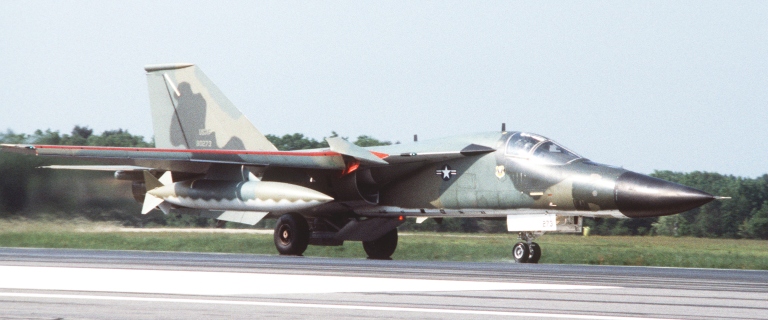 In terms of sizing, combat radius and exceptional survivability, the J-XX [J-20] occupies the same niche as the GD F/FB-111 family of aircraft did, presenting potential for evolution across a wide range of roles. Depicted FB-111A nuclear strategic bomber, EF-111A electronic attack aircraft and F-111B long range interceptor (US DoD images). 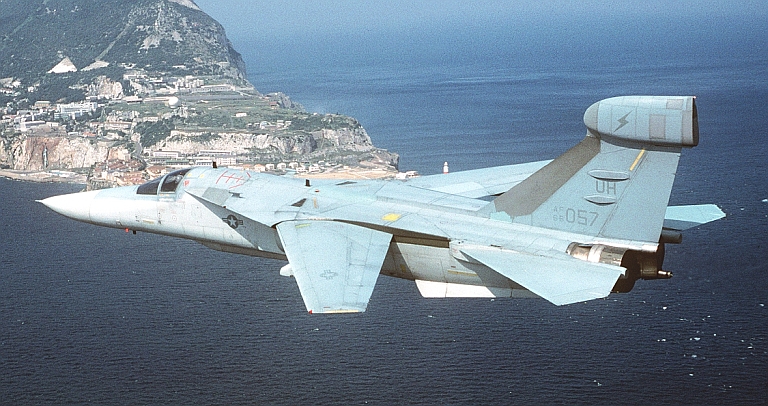 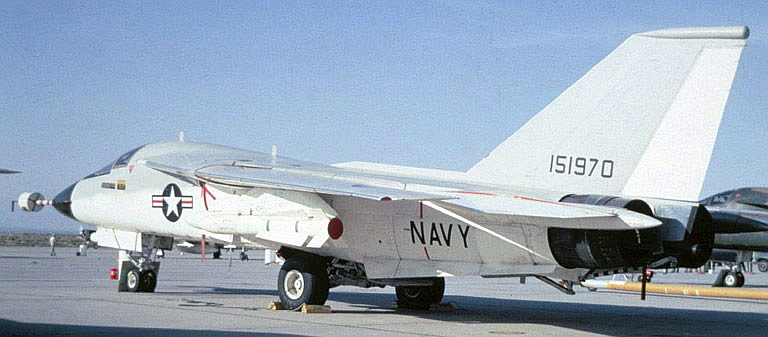 To what extent the PLA-AF and PLA-N air arm opt to exploit the potential of this design, or a derivative design, remains to be seen. Prudent strategic analysis however cannot rely on the notion that the PLA-AF and PLA-N air arm will not make full use of a potential capability the development of which has consumed without doubt considerable national treasure. |
||||||||
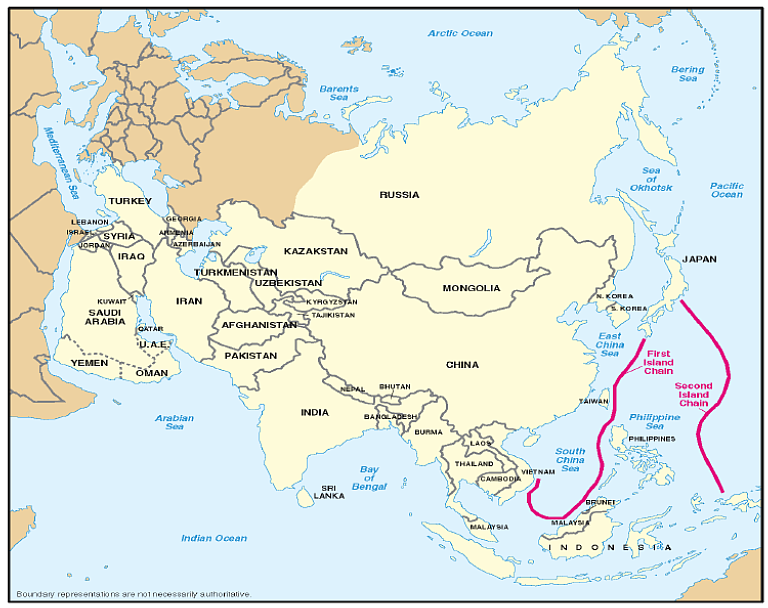  The F-111/FB-22 sized J-XX [J-20]
is clearly built to deny access to the Second Island Chain region
(Chinese Internet).
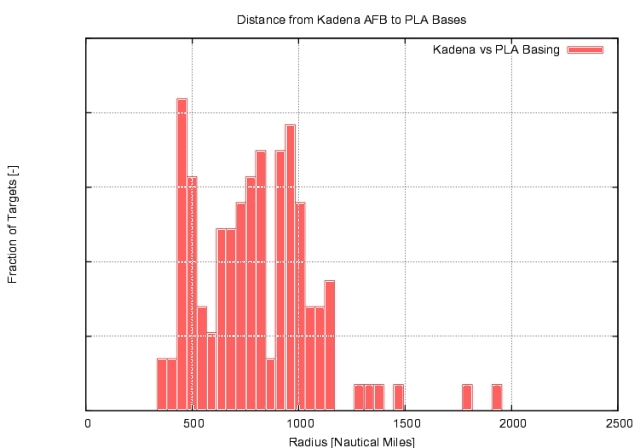 Above, below: Histograms of
distances
between PLA-AF and PLA-N fixed
basing along the eastern seaboard of mainland China and US airfields at
Kadena AFB on Okinawa and Andersen AFB on Guam. The J-XX/J-20 is well
sized to hold both of these bases at risk (Kopp, 2005).
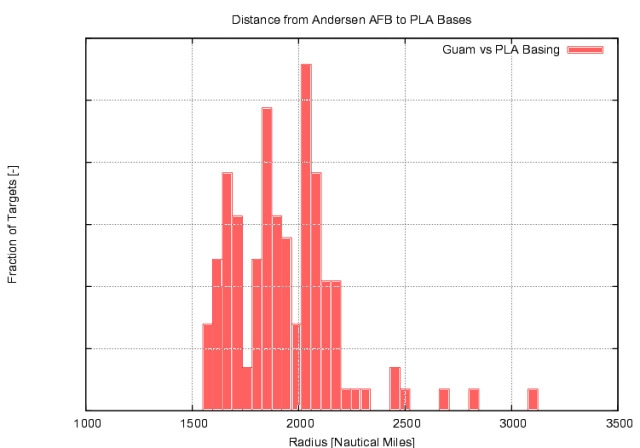 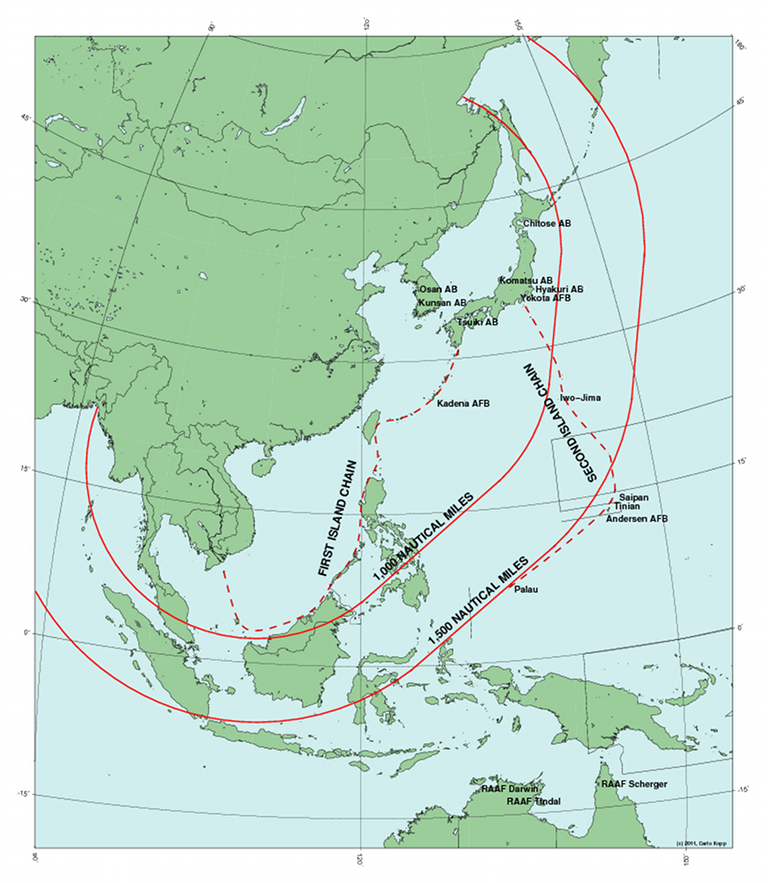 Unrefuelled
combat
radius performance for a Hi-Hi-Hi profile in a fighter in the
size and weight class of the FB-111A typically falls between 1,000 and
1,500 nautical miles, subject to a range of assumptions and engine TSFC
during the profile. This map depicts the geographical coverage
achievable from Anshan AB, Dachang AB and Foluo Northeast AB with
combat radii of 1,000 and 1,500 nautical miles respectively. Azimuthal
equidistant projection centred on Dachang AB (C. Kopp).xiii
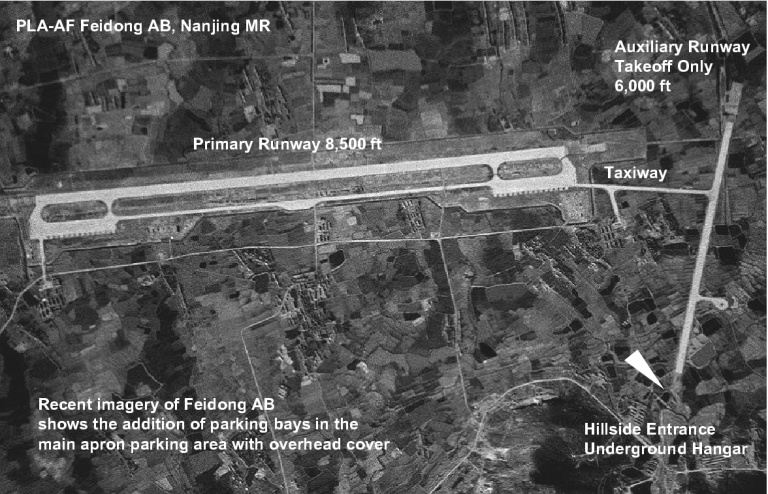 The
PLA-AF
fighter
base
at
Feidong
in the Nanjing MR [Click
for more ...] is a good example
of the design of a “superhardened” fighter base. The primary runway,
available for
takeoffs and landings, has a wide full length parallel taxiway to
enable
recoveries in the event of damage. An auxiliary take-off only alert
runway is directly connected to the underground hangar entrance,
allowing the fighter to roll out of the tunnel, line up, open the
throttles and take off quickly. The PLA invested considerable thought
into planning its network of 'superhardened' fighter bases, usually
placing the runways behind a hill or mountain, relative to the threat
axis.
|
||||||||
|
The
Strategic Impact of the J-XX [J-20] Stealth Fighter
At this time there is no air defence system in Asia, including the organic capabilities of the US Navy CVBGs, which can reliably stop a mature long range supercruising stealth fighter, be it an F-22A Raptor, or a mature production export T-50 PAK-FA, or J-XX [J-20]. Western built Integrated Air Defence Systems (IADS) rely primarily on S-band, and to a lesser extent, L-band and UHF-band acquisition radars for land based, and shipboard use. Airborne Early Warning capabilities are similarly constrained, the E-3/E-767/APY-2 AWACS (US Air Force, Japan) operating in the S-band, the E-737 Wedgetail/MESA (South Korea, Australia) and G.550 CAEW / EL/M-2075 (Singapore) the L-band, and the E-2C/APS-145 (US Navy, Japan, Singapore) and E-2D/APY-9 (US Navy) in the UHF-band. While the L-band MESA and EL/M-2075, and UHF-band APY-9 will have significantly better detection performance against a J-XX [J-20] compared to an S-band radar such as the APY-2 or SPY-1 Aegis, it will be very much lower than that achievable against a non-stealthy conventional aerial targetix. As a result of the introduction of robust stealth capability, the coverage footprint of United States and allied IADS in the WestPac will be severely reduced, no differently than that of the Warsaw Pact IADS when confronted by the F-117A Nighthawk from 1985 onward. The result of this will be large holes in IADS coverage, or to use the colourful late Cold War description, “the gaps between fence pickets become very wide”. Engagement radars employed for Surface-Air
Missile defences, such as
the Patriot MPQ-53/65 and Aegis SPG-62, and most fighter multimode
radars operate in the C/X-band, and some in the Ku-band. Semiactive
and TVM missile seekers mostly operate in the native C/X-band of the
fire control system, while active radar seekers mostly operate in the
Ku-band or above. The effectiveness of all of these systems will be
severely impaired when confronting a mature variant of the J-XX
[J-20]. Intercepting the Chengdu fighter is apt to present the very
same challenges confronted in intercepts flown against the F-22A
Raptor, both in terms of acquisition by radar, guidance of missiles
and kinematic intercept by aircraft or missile.
In the Western world, most intellectual and development effort in air defence radar and missiles since 1991 has been concentrated into two discrete areas, specifically to provide TMD (Theatre Ballistic Missile Defence) capabilities at the upper end, and C-RAM (Counter Rocket Artillery Mortar) capabilities at the lower end. Capabilities to intercept and destroy high performance low observable aircraft and guided munitions have received little if any attention. Conversely, Russia has since 1991 invested most of its intellectual and material effort in air defence radar and missile development into two very different areas. At the upper tier, counter-stealth radars exploiting VHF-band technology have been developed and some exported, while at the lower end, the focus has been firmly on providing C-PGM (Counter-PGM) capabilities to defeat Western smart munitions. China has followed the Russian lead in IADS capability development, with indigenous and imported Russian technologyx. In strategic terms, at the most basic level, a mature production J-XX [J-20] effectively obsoletes nearly all of the IADS infrastructure and systems, air defence fighter fleets and weapons inventories deployed and operated by the United States and its Pacific Rim allies, in a fashion no different to the immediate obsolescence inflicted by the F-117A / B-2A / F-22A upon globally deployed Soviet era IADS, fighters and systems. In any conflict involving China, a well sized fleet of mature production J-XX [J-20] would have significant freedom of action to attack and destroy aerial and surface targets throughout the geography of the Second Island Chain. Pre-emptive strikes such as those flown in previous conflicts by US Air Force B-2A and F-117A stealth aircraft, intended to cripple and thus paralyse IADS and C3I systems, would present a genuine and very serious risk in any standoff or escalated contingency. Moreover, with a robust payload of satellite/inertial guided bombs, a multirole or strike derivative production J-XX [J-20] would have significant capability to shut down United States and allied airfields across the Second Island Chain, in a manner no different to that envisaged by the US Air Force as a prime role for the GBU-39/53 Small Diameter Bomb armed F-22A Raptor – and proposed FB-22. No differently, US Navy CVBGs are at significant risk, adding to the risks posed by the DF-21D ASBMxi. Unlike ballistic missile terminal stages which present terminal guidance challenges in accuracy, and warhead mass limitations, guided bombs delivered by aircraft can be extremely precise and have large warheads, with significant capability to penetrate reinforced concrete, or warship hulls, and high explosive filler payloads of up to many hundreds of kilogramsxii. As the PLA-AF and PLA-N have access to over 200 airfields, most semi-hardened, some well hardened, and a few super-hardened and deep underground, dispersal and continuous relocation of a J-XX [J-20] fleet is a feasible deployment strategy, and one which presents genuine difficulties in countering with pre-emptive air or cruise missile strikesxiii. The supersonic cruise capability and large fuel capacity of the J-XX [J-20] would permit it to be based deeper inside China's territory, compared to older types, further complicating efforts to close down or destroy airfields from which the J-XX [J-20] may be operating, as significant penetration into China's increasingly dense and sophisticated IADS would be required to hit such sites. As the J-XX [J-20] will have close to twice the productivity, in sortie rates achievable compared to conventional non-supercruise types, basing the aircraft deeper inside the IADS would not impair productivity in the manner it would for subsonic cruising types. In terms of China's ability to manufacture and deploy significant numbers of the J-XX [J-20] it is worth observing that in terms of raw “bang for buck” China's defence industry is outperforming the United States' industry by a robust margin. The oft quoted comparisons between the United States and PRC defence budgets produce a misleading picture of the relative scale of investments, especially in terms of equipment recapitalisation. Chinese aggregate defence budgets as cited reflect primarily capital equipment acquisition and support costs, while many infrastructure and personnel costs are born by regional governments. United States budgets tend to carry a significant fraction of operational costs which have been unusually high over the last decade due to the ongoing global conflict with Islamo-fascist insurgent movements. The woeful inefficiency of many portions of the United States defence industry, and procurement bureaucracy, is best exemplified by the fact that the underperforming single engine F-35 is now more expensive than the larger and much better twin engine F-22 Raptor, in terms of Unit Procurement Costs. Many other United States programs display similar symptoms, with overpriced and frequently underperforming products. China has a much healthier manufacturing industry than the United States, and a larger pool of highly skilled personnel, in a job market where personnel costs are tightly controlled. China's ability to rapidly develop both the sophisticated J-XX [J-20] and complex KJ-2000 AWACS over the last decade, with little prior depth in the basic technologies involved, shows an efficient and effective R&D environment, and supporting manufacturing base. The Chengdu J-XX [J-20] thus represents a techno-strategic coup by China, and if deployed in large numbers in a mature configuration, a genuine strategic coup against the United States and its Pacific Rim allies. The development of the Chengdu J-XX [J-20] represents an excellent case study of a well thought out “symmetrical techno-strategic response” to the United States' deployment of stealthy combat aircraft, which no differently to the United States' play in the late Cold War and post Cold War period, elicits a disproportionate response in materiel investment to effectively counter. The only US design with the kinematic performance, stealth performance and sensor capability to be able to confront the J-20 [J-XX] with viable combat lethality and survivability is the F-22A Raptor, or rather, evolved and enhanced variants of the existing configuration of this aircraft. The US Navy F/A-18E/F Super Hornet is outclassed in every respect, and would be as ineffective against a mature J-XX [J-20] as it is against the F-22A Raptor. All variants of the F-35 Joint Strike Fighter would be equally so outclassed, assuming this failed project even progresses to any kind of actual production. All US Air Force, US Navy and allied legacy fighters are outclassed in much the same manner, and are ineffective kinematically and in sensor capability against this class of threat system. The extant IADS technology base of the US Army and Navy and their sister services in Pacific Rim allied nations will be largely ineffective, requiring the replacement of most if not all acquisition radars with VHF-band AESA technology replacements designed to defeat S/X/Ku-band stealth capabilities. From the perspectives of both technological strategy and military grand strategy, the J-XX [J-20] is the final nail in the coffin of the utterly failed “Gates recapitalisation plan” for United States and allied tactical fighter fleets. Apologists for the “Gates fighter recapitalisation plan” will no doubt concoct a plethora of reasons as to why the J-XX [J-20] should be ignored, as they did exactly one year ago when the Russians unveiled the T-50 PAK-FA stealth fighter. The material reality is simple. If the United States does not reverse course in its tactical air fleet and air defence recapitalisation planning, the United States will lose the Pacific Rim to China, with all of the practical and grand strategic consequences which follow from that. |
||||||||
|
||||||||
|
|
||||||||
![Funding APA [Click for more ...] Funding APA [Click for more ...]](APA/Badge-Funding-APA-128.png) |
||||||||
 Chengdu J-20 stealth fighter. This
design outperforms the F/A-18E/F , F-35 JSF and US legacy
fighters in every important
respect (Chinese
Internet).
|
||||||||
|
Notes: i Kopp C. and Goon P.A., Assessing the Sukhoi PAK-FA; Sukhoi/KnAAPO T-50/I-21/Article 701 PAK-FA; Перспективный Авиационный Комплекс Фронтовой Авиации, APA Analyses APA-2010-1, Vol. VII APA-2010-01, Feb 2010, URI: http://www.ausairpower.net/APA-2010-01.html. ii Kopp C. and Goon P.A., Chengdu J-XX [J-20] Stealth Fighter Prototype; A Preliminary Assessment, Technical Report APA-TR-2011-0101, January 2011, URI: http://www.ausairpower.net/APA-J-XX-Prototype.html. iii Gorman S., et al, Computer Spies Breach Fighter-Jet Project, Wall Street Journal, 21st April, 2009, URI: http://online.wsj.com/article/SB124027491029837401.html. iv Kopp C., Assessing Joint Strike Fighter Defence Penetration Capabilities, Air Power Australia Analysis 2009-01, 7th January 2009, URI: http://www.ausairpower.net/APA-2009-01.html and B-2 Variants, GlobalSecurity.org, URI: http://www.globalsecurity.org/wmd/systems/b-2-variants.htm. v Kopp C., MiG's I.42/44 MFI - A First Look, Australian Aviation, March, 1998, URI: http://www.ausairpower.net/Analysis-MiG-MFI.html. vi Stillion J., Orletsky D.T., Airbase Vulnerability to Conventional Cruise-Missile and Ballistic-Missile Attacks; Technology, Scenarios, and U.S. Air Force Responses, Monograph MR-1028, Project Air Force, RAND Corporation, URI: http://www.rand.org/pubs/monograph_reports/MR1028.html. vii Bolkcom C., Air Force FB-22 Bomber Concept, PDF-A/RS21848, March 21, 2005, Congressional Research Service, URI: http://www.fas.org/sgp/crs/weapons/PDF-A/RS21848.pdf. viii Kopp C., Assessing the Impact of Exponential Growth Laws on Future Combat Aircraft Design, Air Power Australia Analysis 2010-04, 31st December 2010, URI: http://www.ausairpower.net/APA-2010-04.html ix AN/APY-9 Radar; Transformational technology for an evolving mission, Lockheed-Martin technical brochure, AN/APY-9 121009, 2009: URI: http://www.lockheedmartin.com/data/assets/ms2/pdf/APY9-1209.pdf. x Kopp C., Evolving Technological Strategy in Advanced Air Defense Systems, Joint Forces Quarterly, Issue 57, 2nd Quarter, April 2010, URI: http://www.ndu.edu/press/jfq_pages/editions/i57/kopp.pdf; also Kopp C., NNIIRT 1L119 Nebo SVU / RLM-M Nebo M; Assessing Russia's First Mobile VHF AESAs, Technical Report APA-TR-2008-0402, April, 2008, URI: http://www.ausairpower.net/APA-Nebo-SVU-Analysis.html. xi Kopp C., Maritime Strike Using The F-22A Raptor, Technical Report APA-TR-2007-0401, April, 2007, URI:http://www.ausairpower.net/Raptor-ASuW.html. xii Kopp C., Hardening RAAF Air Base Infrastructure, Air Power Australia Analysis 2008-02, Vol. V APA-2008-02, 5th February, 2008, URI: http://www.ausairpower.net/APA-2008-02.html. xiii Kopp C., People's Liberation Army Air Force and Naval Air Arm Air Base Infrastructure, Technical Report APA-TR-2007-0103, 30th January 2007, URI: http://www.ausairpower.net/APA-PLA-AFBs.html. |
||||||||
| © 2011, Carlo Kopp |
||||||||
![[Click for more...]](APA/F-22-Banner-2009.png) |
||||||||
Air Power Australia Website - http://www.ausairpower.net/ Air Power Australia Research and Analysis - http://www.ausairpower.net/research.html  |
||||||||
| |
|
|||||||||||||
![Sukhoi PAK-FA and Flanker Index Page [Click for more ...]](APA/flanker.png) |
![F-35 Joint Strike Fighter Index Page [Click for more ...]](APA/jsf.png) |
![Weapons Technology Index Page [Click for more ...]](APA/weps.png) |
![News and Media Related Material Index Page [Click for more ...]](APA/media.png) |
||||||||||
![Surface to Air Missile Systems / Integrated Air Defence Systems Index Page [Click for more ...]](APA/sams-iads.png) |
![Ballistic Missiles and Missile Defence Page [Click for more ...]](APA/msls-bmd.png) |
![Air Power and National Military Strategy Index Page [Click for more ...]](APA/strategy.png) |
![Military Aviation Historical Topics Index Page [Click for more ...]](APA/history.png)
|
![Information Warfare / Operations and Electronic Warfare Index Page [Click for more ...]](APA/iw.png) |
![Systems and Basic Technology Index Page [Click for more ...]](APA/technology.png) |
![Related Links Index Page [Click for more ...]](APA/links.png) |
|||||||
![Homepage of Australia's First Online Journal Covering Air Power Issues (ISSN 1832-2433) [Click for more ...]](APA/apa-analyses.png) |
|||||||||||||
| Artwork, graphic design, layout and text © 2004 - 2014 Carlo Kopp; Text © 2004 - 2014 Peter Goon; All rights reserved. Recommended browsers. Contact webmaster. Site navigation hints. Current hot topics. | |||||||||||||
|
Site Update
Status:
$Revision: 1.753 $
Site History: Notices
and
Updates / NLA Pandora Archive
|
|||||||||||||
|
|
Tweet | Follow @APA_Updates | |||||||||||
|
|
|||||||||||||
|
|
|||||||||||||